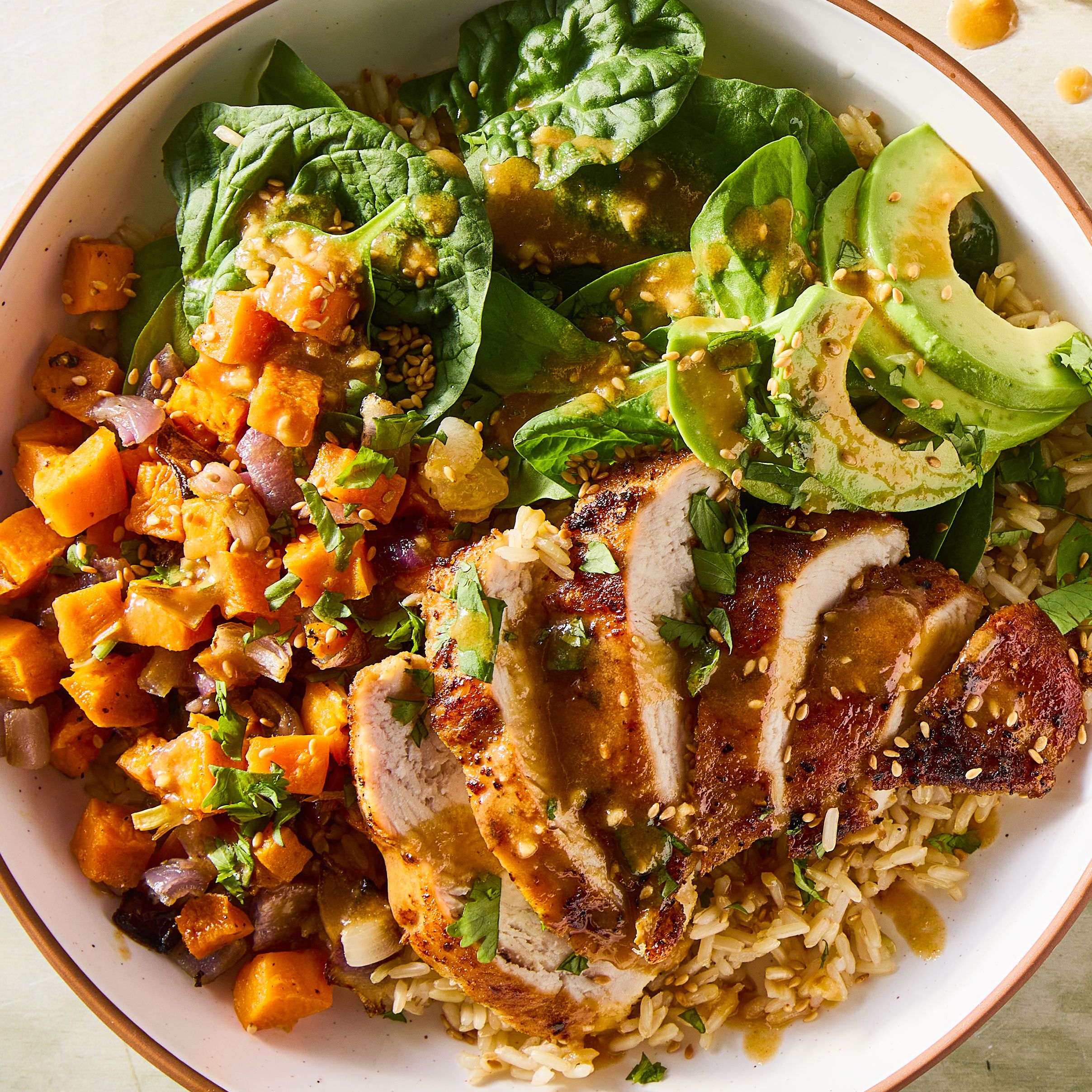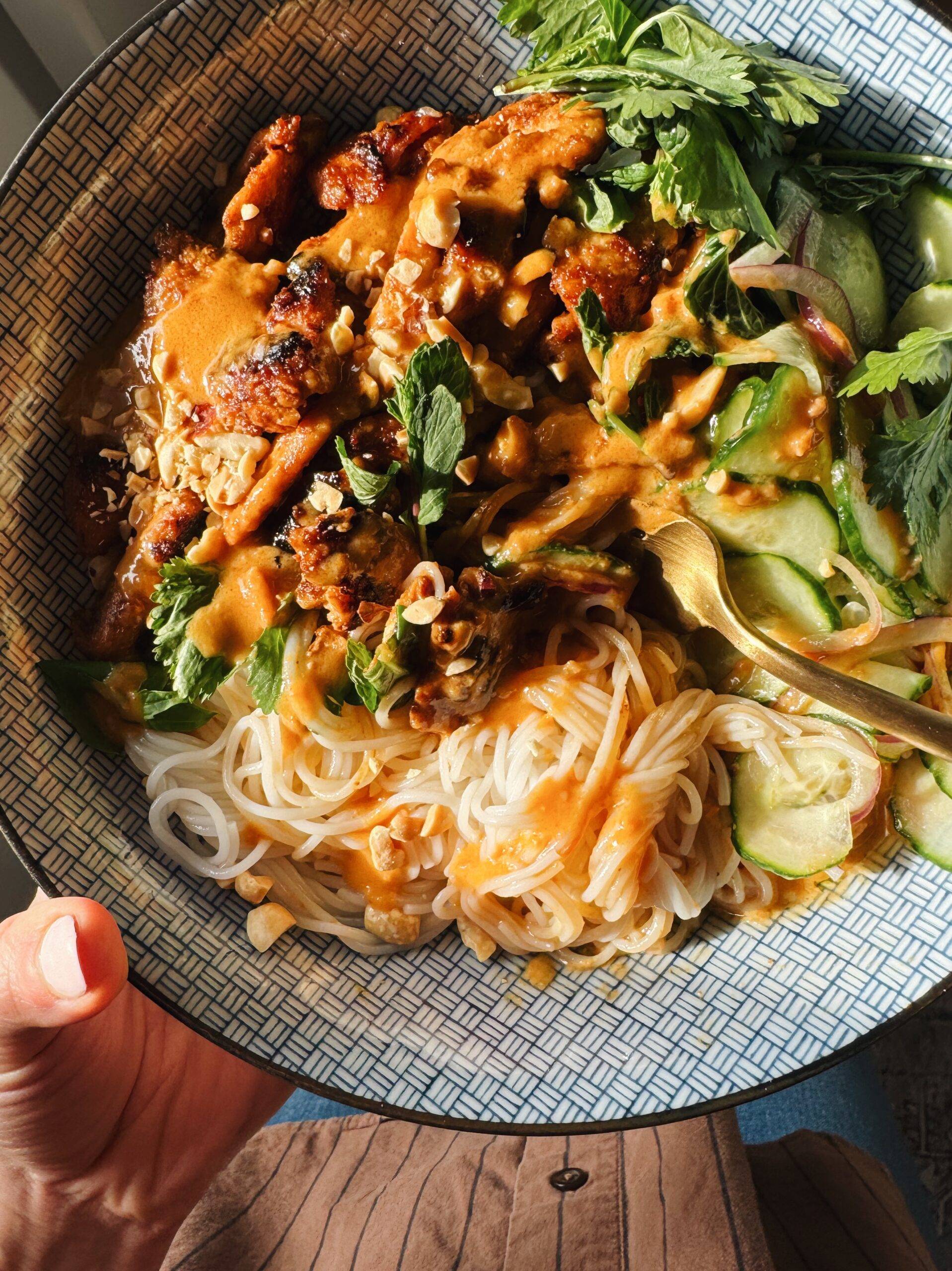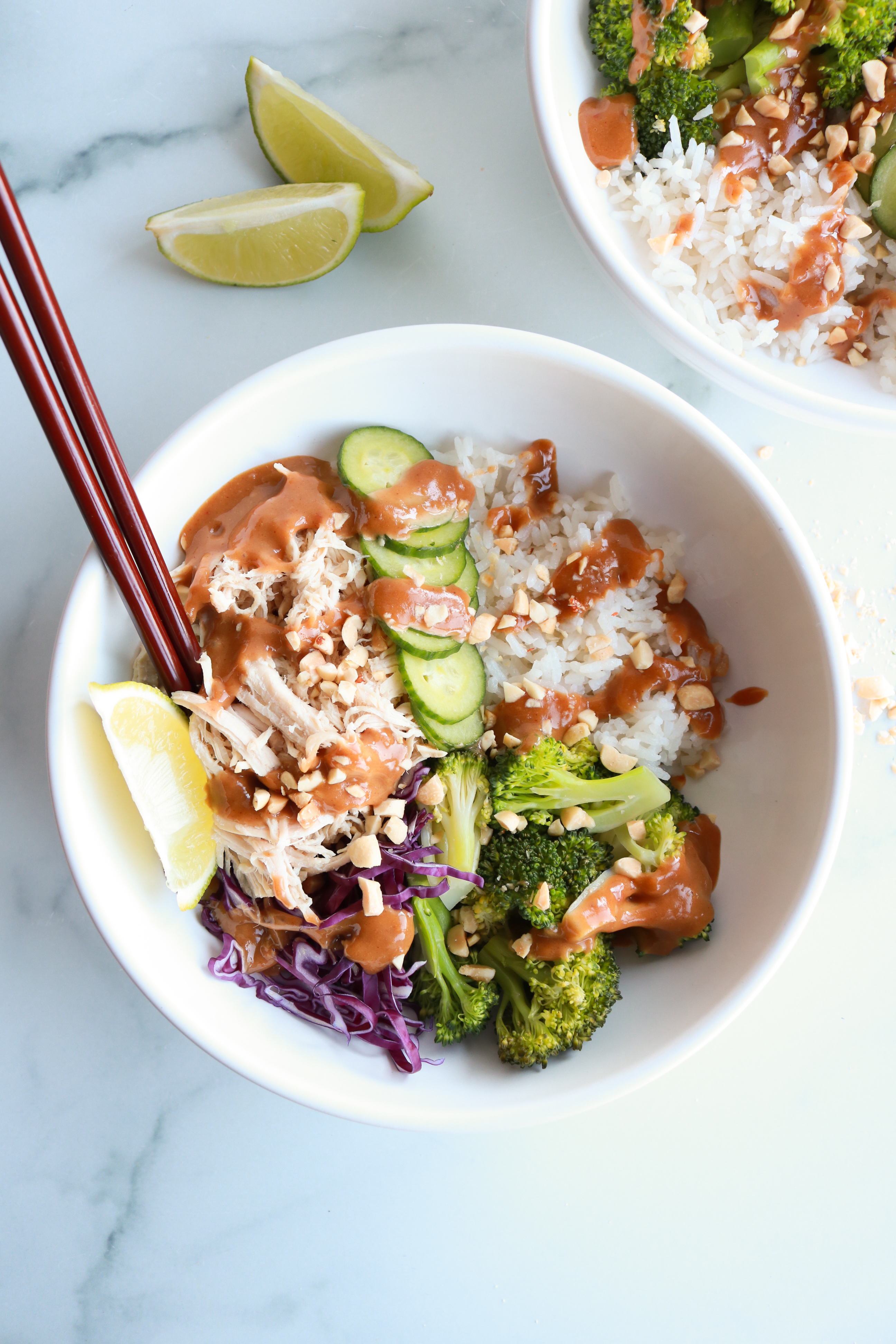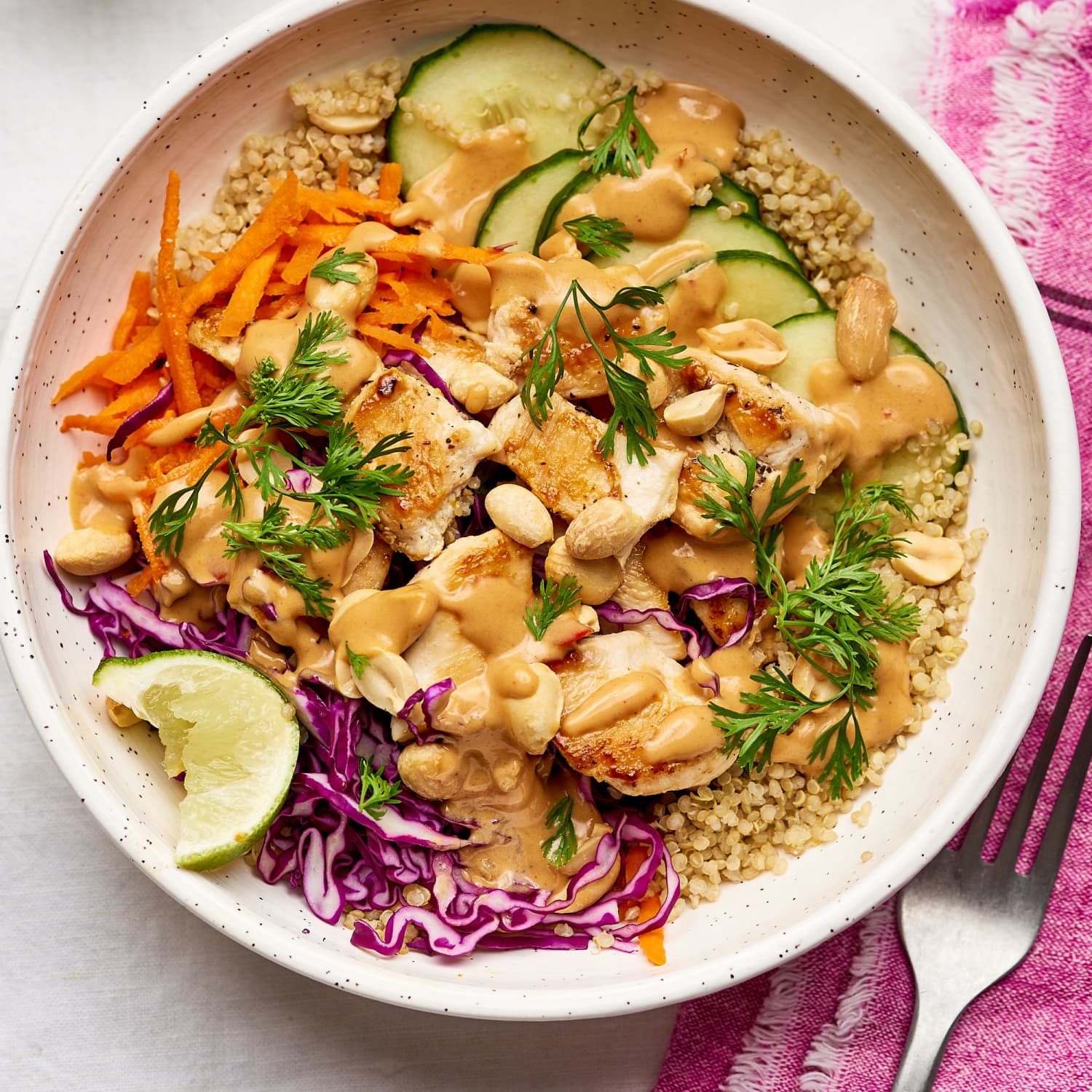
A vibrant Peanut Chicken Protein Bowl featuring grilled chicken, fresh veggies, and a creamy peanut sauce.
In today’s fast-paced world, finding meals that are both delicious and packed with nutrients can feel like a challenge. Enter the Peanut Chicken Protein Bowl – a versatile, flavorful dish that’s taking the health food scene by storm. Combining tender chicken, crunchy vegetables, hearty grains, and a rich peanut sauce, this bowl isn’t just a meal; it’s a powerhouse of protein and essential nutrients designed to fuel your day. Whether you’re an athlete looking to build muscle, a busy professional needing quick meal prep options, or someone simply aiming for balanced eating, this dish offers something for everyone.
The concept of protein bowls has evolved from simple salad alternatives to sophisticated meals that blend global flavors with nutritional science. Inspired by Thai and Asian cuisines, the peanut chicken variant stands out for its creamy, nutty sauce that elevates basic ingredients into a gourmet experience. According to recent recipes from culinary experts, these bowls can provide up to 51 grams of protein per serving, making them ideal for post-workout recovery or sustained energy throughout the day.
But what makes this bowl truly special? It’s the perfect harmony of macros – high protein from the chicken, healthy fats from peanuts and avocados, complex carbs from grains like rice or quinoa, and fiber from a rainbow of veggies. In this comprehensive guide, we’ll dive deep into everything you need to know about Peanut Chicken Protein Bowls. From their health benefits and ingredient breakdowns to a step-by-step recipe, variations, and tips for integration into your lifestyle, this article will equip you with the knowledge to make this dish a staple in your kitchen.
If you’re new to protein-packed meals, check out our internal guide on building balanced bowls for more inspiration. For those interested in the science behind nutrition, external resources like the https://tastetrove.net provide detailed breakdowns of ingredient values.
The Rise of Protein Bowls in Modern Diets
Protein bowls have surged in popularity over the last decade, driven by a growing emphasis on health, wellness, and convenience. What started as a trend in fitness communities has now become mainstream, with cafes and meal delivery services offering endless variations. The Peanut Chicken Protein Bowl, in particular, draws from traditional satay dishes but adapts them for modern palates by incorporating superfoods and customizable elements.
Historically, bowls like these trace back to Asian street food, where peanut sauces were used to add depth to grilled meats and veggies. Today, they’re praised for their meal prep potential – you can assemble them in advance and enjoy them cold or reheated. A study on dietary trends highlights how such meals help in weight management by promoting satiety through high protein and fiber content.
In the context of current health movements, these bowls align perfectly with low-carb, keto, or paleo diets when modified. For instance, swapping rice for cauliflower rice reduces carbs while maintaining flavor. Social media platforms are flooded with user-generated content showcasing creative twists, from spicy versions to vegan alternatives using tofu.
Why focus on protein? Protein is essential for muscle repair, hormone production, and immune function. The average adult needs about 0.8 grams per kilogram of body weight, but active individuals may require up to 1.6-2.2 grams. Bowls like this make hitting those targets effortless and enjoyable.
For more on protein’s role in diets, explore our protein essentials article. Externally, the Harvard School of Public Health offers in-depth insights.
Health Benefits of Peanut Chicken Protein Bowls

Thai-inspired Peanut Chicken Bowl with noodles, cucumbers, and fresh herbs for a refreshing twist.
Diving into the nutritional perks, Peanut Chicken Protein Bowls are a treasure trove of health benefits. Starting with the star ingredient – chicken – which provides lean, high-quality protein that’s easily digestible and low in saturated fats. A single serving can deliver 25-30 grams of protein, supporting muscle growth and repair, especially beneficial for those engaged in strength training or endurance sports.
The peanut sauce adds more than just flavor; peanuts are rich in monounsaturated fats, which promote heart health by lowering bad cholesterol levels. They also contain resveratrol, an antioxidant linked to reduced inflammation and improved blood sugar control. Combined with veggies like broccoli and spinach, the bowl becomes a fiber powerhouse, aiding digestion and preventing blood sugar spikes.
Let’s break it down further:
- Muscle Building and Recovery: With protein levels rivaling a steak dinner but in a lighter format, these bowls are perfect post-gym. The amino acids in chicken help rebuild tissues, while peanuts provide arginine for better blood flow.
- Weight Management: High protein and fiber content increases fullness, reducing overall calorie intake. One recipe variant notes that the inclusion of sweet potatoes adds complex carbs for sustained energy without excess calories.
- Immune Support: Ingredients like garlic, ginger, and lime in the sauce offer antiviral properties. Veggies contribute vitamins A, C, and K, bolstering your body’s defenses.
- Heart Health: Avocados and peanuts supply healthy fats that combat cardiovascular risks. Studies show regular nut consumption can lower heart disease by 20-30%.
- Blood Sugar Regulation: The low glycemic index of whole grains and veggies, paired with protein, helps stabilize glucose levels, making this ideal for diabetics or those watching carbs.
Moreover, these bowls are anti-inflammatory due to spices like turmeric or chili, which can be added for an extra kick. For athletes, the electrolyte-rich veggies help with hydration and recovery.
If you’re tracking macros, tools like MyFitnessPal can help customize. Internally, see our anti-inflammatory foods list.
Key Ingredients and Their Nutritional Profiles
The magic of Peanut Chicken Protein Bowls lies in their ingredients, each chosen for flavor and function. Here’s a detailed breakdown:
- Chicken Breast (Protein Source): Lean and versatile, 100g provides about 31g protein and only 165 calories. It’s rich in B vitamins for energy metabolism.
- Peanut Butter (Sauce Base): Natural peanut butter offers 8g protein per 2 tbsp, plus healthy fats and vitamin E for skin health. Opt for unsweetened to avoid added sugars.
- Vegetables (Fiber and Vitamins): Broccoli (vitamin C booster), carrots (beta-carotene for vision), cucumber (hydration), red cabbage (antioxidants), and avocado (potassium-rich for heart function). Together, they add crunch and color while keeping calories low.
- Grains/Base (Carbs): Brown rice or quinoa for sustained energy. Quinoa is a complete protein with all nine essential amino acids, providing 8g protein per cup cooked.
- Sauce Add-Ins: Soy sauce for umami, lime for tang, ginger for digestion, garlic for immunity, and honey or maple for a touch of sweetness.
- Toppings: Sesame seeds for calcium, cilantro for detox, and crushed peanuts for texture.
Nutritionally, a typical bowl might clock in at 500-700 calories, with 40-50g protein, 20-30g fat, and 40-60g carbs, depending on portions. For sourcing, consider organic options from Whole Foods.
Explore our ingredient spotlights for more details.
Step-by-Step Recipe Guide

A simple Peanut Chicken Bowl with rice, broccoli, and a drizzle of peanut sauce.
Ready to cook? This recipe serves 4 and takes about 45 minutes. It’s inspired by popular versions but customized for balance.
Ingredients:
- 1 lb chicken breast, cubed
- 1 cup brown rice or quinoa
- 2 cups mixed veggies (broccoli, carrots, cabbage)
- 1 avocado, sliced
- For sauce: 1/4 cup peanut butter, 2 tbsp soy sauce, 1 tbsp lime juice, 1 tsp ginger, 1 garlic clove, 1 tbsp honey, water to thin
Steps:
- Cook the base: Rinse 1 cup rice, boil with 2 cups water, simmer 20-25 min until fluffy.
- Prep chicken: Marinate cubes in soy, ginger, garlic for 15 min. Sauté in oil over medium heat 8-10 min until golden.
- Steam veggies: Broccoli and carrots for 5 min to retain crunch.
- Make sauce: Whisk peanut butter, soy, lime, honey, ginger, garlic, and water until smooth.
- Assemble: Layer rice, veggies, chicken, avocado. Drizzle sauce, top with peanuts and cilantro.
Tips: Use an air fryer for crispier chicken. For low-carb, use cauliflower rice.
Full nutrition per serving: ~600 cal, 45g protein, 25g fat, 50g carbs.
For video tutorials, check YouTube cooking channels. Internally, link to our sauce recipes.
Variations for Different Dietary Needs
One of the best aspects of these bowls is their adaptability.
- Vegan Version: Swap chicken for tofu or chickpeas. The sauce remains the same, providing plant-based protein.
- Spicy Twist: Add sriracha or chili flakes for heat, boosting metabolism.
- Low-Carb/Keto: Use zoodles or greens instead of grains, keeping carbs under 20g.
- Gluten-Free: Ensure soy sauce is tamari.
- High-Calorie for Bulking: Add more nuts or double the chicken.
- Kid-Friendly: Mild sauce, fun veggie shapes.
Experiment with sweet potato for a Thai-inspired sweet note.
See our vegan adaptations for more ideas.
Meal Prep Tips and Storage

Power-packed Peanut Chicken Bowl with quinoa, cabbage, and fresh dill.
These bowls shine in meal prep. Prepare components separately: Cook chicken and rice in batches, chop veggies fresh. Store in airtight containers for up to 4 days in the fridge. Sauce separately to avoid sogginess.
Reheat chicken and base, add cold toppings. For freezing, portion without sauce; thaw overnight.
Pro tip: Use mason jars for layered portability. This method saves time and ensures balanced meals all week.
For storage gear, check Amazon meal prep containers. Internally, meal prep guide.
Pairing Suggestions
Pair with a green tea for antioxidants or a protein shake for extra boost. For dinner, add a side salad. Wine? A light white like Sauvignon Blanc complements the nutty flavors.
Incorporate into weekly plans: Breakfast variation with eggs, lunch as is, dinner with added fish.
Common Mistakes and How to Avoid Them
Avoid overcooking chicken – aim for 165°F internal temp. Don’t make sauce too thick; thin with water. Balance flavors: Taste and adjust acidity with lime.
Allergies? Sub almond butter for peanuts.
For troubleshooting, see cooking FAQs.
Conclusion

Ginger-infused Peanut Chicken Bowl with mango and avocado for a tropical flair.
Peanut Chicken Protein Bowls are more than a trend – they’re a sustainable way to enjoy nutritious, flavorful food. With their high protein, customizable nature, and ease of preparation, they fit seamlessly into any lifestyle. Try the recipe today and experience the benefits firsthand.
For more recipes, visit our home page. External inspiration from EatingWell.
